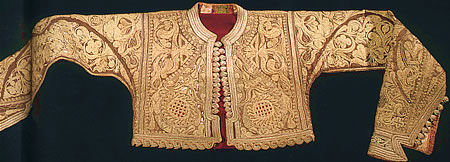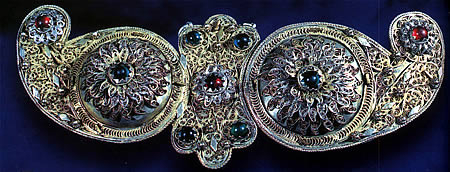 |
|
Macedonian Folklore
"We keep repeating those ancient, created-God-knows-when poems, riddles, proverbs, magic spells, curses and tales, and they appear before us in a new, unknown glamour, with untouched freshness, as if they were created today. And it shall remain so for as long as the Sun shines and the Earth moves, and as long as our magic tongue exists. As long as we relentlessly restore love, always differently and always faithfully to folk poetry."
Until the beginnings of Renaissance in Macedonia in the middle of the 19th century, there had hardly been any interest in collecting folk works due to the political and cultural circumstances in Ottoman-ruled Macedonia until that time. Even the first Macedonian writers, Kiril Pejcinovic and Joakim Krcoski, had a negative attitude towards folk poetry and considered its powerful effect and widespread use among the masses as damaging. This is hardly surprising if we know that they were clergymen, and like all religious personages, they insisted on promoting church literature as more virtuous than the livelier and more liberal folk poetry.

In the second half of the 19 th century, however, there was a sudden change of affairs. In their fight against foreign reign and assimilation, the most distinguished Macedonian intellectuals of the Renaissance focused their interest on the folk tradition and heritage as a powerful weapon for creating a national culture. The author of the first published collection of Macedonian folk poems, Stefan Verkovic, emphasised this in his work: "That this Slavonic branch never died out or got assimilated can only be ascribed to the fact that people spend most of their lives in their villages working in the fields, talking to others, telling stories and reciting their poems." Such and similar views were expressed by other collectors of folk literary works, like the Miladinov brothers, Kuzman Sapkarev, Marko Cepenkov , to mention but a few.
The 19 th century was the most fruitful period in creating and publishing folk collections, both in size and value. The best collections and isolated works published in various newspapers and magazines belong to Macedonians. However, Macedonian folk works were also collected by a host of Bulgarians, Serbs, and Russians. Surely, their collections are a valuable contribution to the rich heritage of the Macedonian folk treasure, although one could often come across misinterpretations regarding their national character, as well as linguistic and other interferences with certain political intentions.

The entire work of collecting and research in the field of the Macedonian folklore is classified into four periods. The first period covers the first signs of interest in the Macedonian folklore until the beginning of the Renaissance, i.e. until the publication of the first Collection of Macedonian Folk Poems in 1860. The second period coincides with the time up to World War I, the third period is up to World War II, and the fourth period covers the national liberation war, the liberation and the years after it until the present day.
From The Macedonian Folklore by Kiril Penusliski
|
|
|
|
|
|
|
|
|